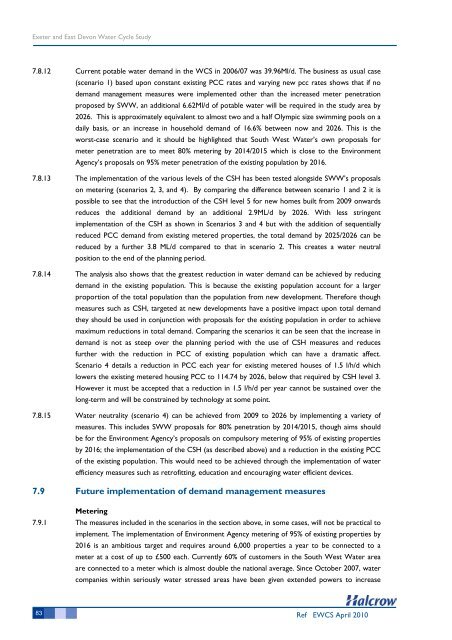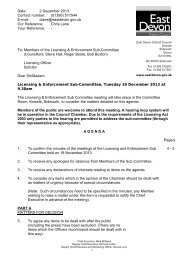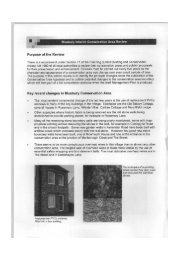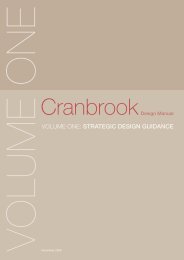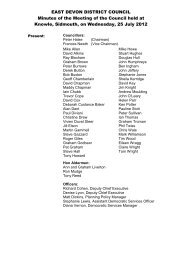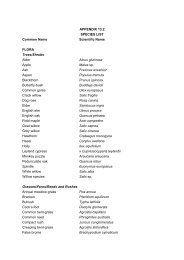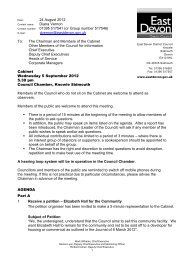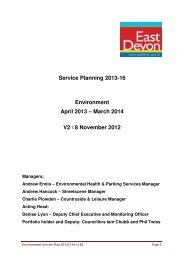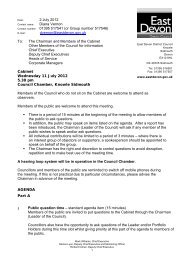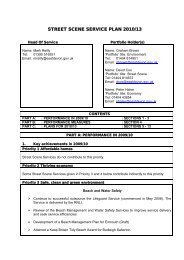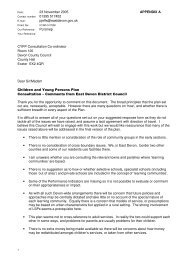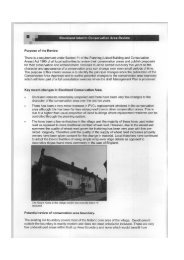Water Cycle Study - East Devon District Council
Water Cycle Study - East Devon District Council
Water Cycle Study - East Devon District Council
Create successful ePaper yourself
Turn your PDF publications into a flip-book with our unique Google optimized e-Paper software.
Exeter and <strong>East</strong> <strong>Devon</strong> <strong>Water</strong> <strong>Cycle</strong> <strong>Study</strong><br />
7.8.12 Current potable water demand in the WCS in 2006/07 was 39.96Ml/d. The business as usual case<br />
(scenario 1) based upon constant existing PCC rates and varying new pcc rates shows that if no<br />
demand management measures were implemented other than the increased meter penetration<br />
proposed by SWW, an additional 6.62Ml/d of potable water will be required in the study area by<br />
2026. This is approximately equivalent to almost two and a half Olympic size swimming pools on a<br />
daily basis, or an increase in household demand of 16.6% between now and 2026. This is the<br />
worst-case scenario and it should be highlighted that South West <strong>Water</strong>’s own proposals for<br />
meter penetration are to meet 80% metering by 2014/2015 which is close to the Environment<br />
Agency’s proposals on 95% meter penetration of the existing population by 2016.<br />
7.8.13 The implementation of the various levels of the CSH has been tested alongside SWW’s proposals<br />
on metering (scenarios 2, 3, and 4). By comparing the difference between scenario 1 and 2 it is<br />
possible to see that the introduction of the CSH level 5 for new homes built from 2009 onwards<br />
reduces the additional demand by an additional 2.9ML/d by 2026. With less stringent<br />
implementation of the CSH as shown in Scenarios 3 and 4 but with the addition of sequentially<br />
reduced PCC demand from existing metered properties, the total demand by 2025/2026 can be<br />
reduced by a further 3.8 ML/d compared to that in scenario 2. This creates a water neutral<br />
position to the end of the planning period.<br />
7.8.14 The analysis also shows that the greatest reduction in water demand can be achieved by reducing<br />
demand in the existing population. This is because the existing population account for a larger<br />
proportion of the total population than the population from new development. Therefore though<br />
measures such as CSH, targeted at new developments have a positive impact upon total demand<br />
they should be used in conjunction with proposals for the existing population in order to achieve<br />
maximum reductions in total demand. Comparing the scenarios it can be seen that the increase in<br />
demand is not as steep over the planning period with the use of CSH measures and reduces<br />
further with the reduction in PCC of existing population which can have a dramatic affect.<br />
Scenario 4 details a reduction in PCC each year for existing metered houses of 1.5 l/h/d which<br />
lowers the existing metered housing PCC to 114.74 by 2026, below that required by CSH level 3.<br />
However it must be accepted that a reduction in 1.5 l/h/d per year cannot be sustained over the<br />
long-term and will be constrained by technology at some point.<br />
7.8.15 <strong>Water</strong> neutrality (scenario 4) can be achieved from 2009 to 2026 by implementing a variety of<br />
measures. This includes SWW proposals for 80% penetration by 2014/2015, though aims should<br />
be for the Environment Agency’s proposals on compulsory metering of 95% of existing properties<br />
by 2016; the implementation of the CSH (as described above) and a reduction in the existing PCC<br />
of the existing population. This would need to be achieved through the implementation of water<br />
efficiency measures such as retrofitting, education and encouraging water efficient devices.<br />
7.9 Future implementation of demand management measures<br />
Metering<br />
7.9.1 The measures included in the scenarios in the section above, in some cases, will not be practical to<br />
implement. The implementation of Environment Agency metering of 95% of existing properties by<br />
2016 is an ambitious target and requires around 6,000 properties a year to be connected to a<br />
meter at a cost of up to £500 each. Currently 60% of customers in the South West <strong>Water</strong> area<br />
are connected to a meter which is almost double the national average. Since October 2007, water<br />
companies within seriously water stressed areas have been given extended powers to increase<br />
83 Ref EWCS April 2010


